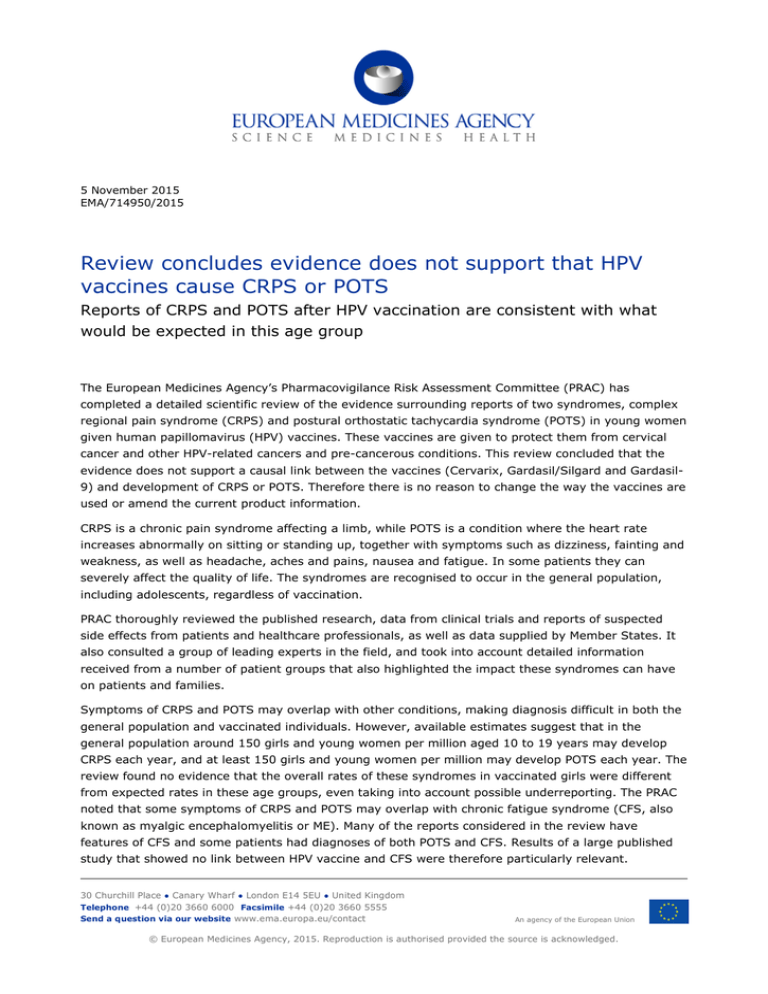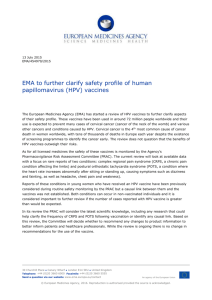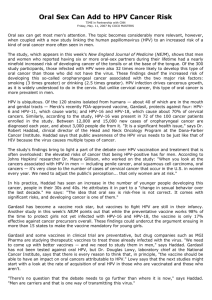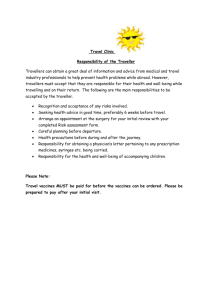Review concludes evidence does not support that HPV
advertisement

5 November 2015 EMA/714950/2015 Review concludes evidence does not support that HPV vaccines cause CRPS or POTS Reports of CRPS and POTS after HPV vaccination are consistent with what would be expected in this age group The European Medicines Agency’s Pharmacovigilance Risk Assessment Committee (PRAC) has completed a detailed scientific review of the evidence surrounding reports of two syndromes, complex regional pain syndrome (CRPS) and postural orthostatic tachycardia syndrome (POTS) in young women given human papillomavirus (HPV) vaccines. These vaccines are given to protect them from cervical cancer and other HPV-related cancers and pre-cancerous conditions. This review concluded that the evidence does not support a causal link between the vaccines (Cervarix, Gardasil/Silgard and Gardasil9) and development of CRPS or POTS. Therefore there is no reason to change the way the vaccines are used or amend the current product information. CRPS is a chronic pain syndrome affecting a limb, while POTS is a condition where the heart rate increases abnormally on sitting or standing up, together with symptoms such as dizziness, fainting and weakness, as well as headache, aches and pains, nausea and fatigue. In some patients they can severely affect the quality of life. The syndromes are recognised to occur in the general population, including adolescents, regardless of vaccination. PRAC thoroughly reviewed the published research, data from clinical trials and reports of suspected side effects from patients and healthcare professionals, as well as data supplied by Member States. It also consulted a group of leading experts in the field, and took into account detailed information received from a number of patient groups that also highlighted the impact these syndromes can have on patients and families. Symptoms of CRPS and POTS may overlap with other conditions, making diagnosis difficult in both the general population and vaccinated individuals. However, available estimates suggest that in the general population around 150 girls and young women per million aged 10 to 19 years may develop CRPS each year, and at least 150 girls and young women per million may develop POTS each year. The review found no evidence that the overall rates of these syndromes in vaccinated girls were different from expected rates in these age groups, even taking into account possible underreporting. The PRAC noted that some symptoms of CRPS and POTS may overlap with chronic fatigue syndrome (CFS, also known as myalgic encephalomyelitis or ME). Many of the reports considered in the review have features of CFS and some patients had diagnoses of both POTS and CFS. Results of a large published study that showed no link between HPV vaccine and CFS were therefore particularly relevant. 30 Churchill Place ● Canary Wharf ● London E14 5EU ● United Kingdom Telephone +44 (0)20 3660 6000 Facsimile +44 (0)20 3660 5555 Send a question via our website www.ema.europa.eu/contact An agency of the European Union © European Medicines Agency, 2015. Reproduction is authorised provided the source is acknowledged. The PRAC concluded that the available evidence does not support that CRPS and POTS are caused by HPV vaccines. Therefore there is no reason to change the way the vaccines are used or amend the current product information. The review recognised that more than 80 million girls and women worldwide have now received these vaccines, and in some European countries they have been given to 90% of the age group recommended for vaccination. Use of these vaccines is expected to prevent many cases of cervical cancer (cancer of the neck of the womb, which is responsible for tens of thousands of deaths in Europe each year) and various other cancers and conditions caused by HPV. The benefits of HPV vaccines therefore continue to outweigh their risks. The safety of these vaccines, as with all medicines, will continue to be carefully monitored. The PRAC’s recommendations will now be passed to the Committee for Medicinal Products for Human Use (CHMP) for adoption of the Agency’s final position. The evidence supporting the PRAC review will be published in an assessment report following the CHMP opinion. More about the medicine HPV vaccines are available in the European Union under the names Gardasil/Silgard, Gardasil 9, and Cervarix. Gardasil has been authorised since September 2006, and is approved for use in males and females for preventing precancerous growths and cancer in the cervix and anus, and genital warts. It protects against 4 types of HPV (types 6, 11, 16 and 18). Gardasil 9 (approved in June 2015) is used similarly but protects against 9 types of the virus (types 6, 11, 16, 18, 31, 33, 45, 52 and 58). Cervarix has been approved since September 2007 for use in women and girls to protect against precancerous growths and cancer in the cervix and genital area. It is active against types 16 and 18 of the virus. Following their approval, the vaccines have been introduced in national immunisation programs in many countries. It is estimated that more than 63 million girls and women worldwide have been vaccinated with Gardasil/Silgard and more than 19 million with Cervarix. More about the procedure The review of HPV vaccines was initiated on 9 July 2015 by the European Commission at the request of Denmark, under Article 20 of Regulation (EC) No 726/2004. The review has been carried out by the Pharmacovigilance Risk Assessment Committee (PRAC), the Committee responsible for the evaluation of safety issues for human medicines, which has made a set of recommendations. These PRAC recommendations will now be sent to the Committee for Medicinal Products for Human Use (CHMP), responsible for questions concerning medicines for human use, which will adopt the Agency’s final opinion. The final stage of the review procedure is the adoption by the European Commission of a legally binding decision applicable in all EU Member States. Contact our press officer Monika Benstetter Tel. +44 (0)20 3660 8427 E-mail: press@ema.europa.eu Review concludes evidence does not support that HPV vaccines cause CRPS or POTS EMA/714950/2015 Page 2/2





